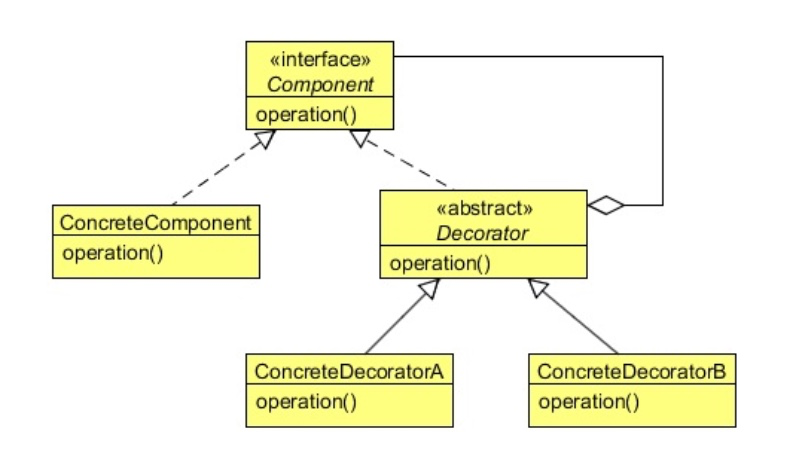设计模式-装饰模式
2019-06-30 / 3 min read
定义
Attach additional responsibilities to an object dynamically keeping the same interface.Decorators provide a flexible alternative to subclassing for extending functionality.(动态地给一个对象添加一些额外的职责。就增加功能来说,装饰模式相比生成子类更为灵活。)
UML

代码实现
/**
* Component是一个接口或者是抽象类,就是定义我们最核心的对象,也就是最原始的对象
*/
public abstract class Component {
//抽象的方法
public abstract void operate();
}
public class ConcreteComponent extends Component {
//具体实现
@Override
public void operate() {
System.out.println("do Something");
}
}
public abstract class Decorator extends Component {
private Component component = null;
//通过构造函数传递被修饰者
public Decorator(Component _component){
this.component = _component;
}
//委托给被修饰者执行
@Override
public void operate() {
this.component.operate();
}
}
public class ConcreteDecorator1 extends Decorator {
//定义被修饰者
public ConcreteDecorator1(Component _component){
super(_component);
}
//定义自己的修饰方法
private void method1(){
System.out.println("method1 修饰");
}
//重写父类的Operation方法
public void operate(){
this.method1();
super.operate();
}
}
public class ConcreteDecorator2 extends Decorator {
//定义被修饰者
public ConcreteDecorator2(Component _component){
super(_component);
}
//定义自己的修饰方法
private void method2(){
System.out.println("method2修饰");
}
//重写父类的Operation方法
public void operate(){
super.operate();
this.method2();
}
}
public class Client {
public static void main(String[] args) {
Component component = new ConcreteComponent();
//第一次修饰
component = new ConcreteDecorator1(component);
//第二次修饰
component = new ConcreteDecorator2(component);
//修饰后运行
component.operate();
}
}
装饰者模式的优点
- 装饰类和被装饰类可以独立发展,而不会相互耦合。换句话说,Component类无须知道Decorator类,Decorator类是从外部来扩展Component类的功能,而Decorator也不用知道具体的构件。
- 装饰模式是继承关系的一个替代方案。我们看装饰类Decorator,不管装饰多少层,返回的对象还是Component,实现的还是is-a的关系。
- 装饰模式可以动态地扩展一个实现类的功能,这不需要多说,装饰模式的定义就是如此。
装饰者模式的缺点
对于装饰模式记住一点就足够了:多层的装饰是比较复杂的。为什么会复杂呢?你想想看,就像剥洋葱一样,你剥到了最后才发现是最里层的装饰出现了问题,想象一下工作量吧,因此,尽量减少装饰类的数量,以便降低系统的复杂度。
装饰者模式的使用场景
- 需要扩展一个类的功能,或给一个类增加附加功能。
- 需要动态地给一个对象增加功能,这些功能可以再动态地撤销。
- 需要为一批的兄弟类进行改装或加装功能,当然是首选装饰模式。
JDK中的装饰器模式
- java.io.BufferedInputStream(InputStream)
- java.io.DataInputStream(InputStream)
- java.io.BufferedOutputStream(OutputStream)
- java.util.zip.ZipOutputStream(OutputStream)
- java.util.Collections#checkedList|Map|Set|SortedSet|SortedMap